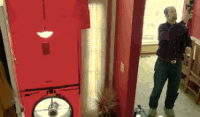TESTS TO FIND AIR LEAKS
We are more aware of air infiltration through small openings and cracks around doors and windows than of air infiltration through the attic floor or through crawlspaces and basements. But the more important air leaks, especially in wood-frame homes, are not around windows and doors. They are often hidden and largely unnoticed.
And that's where blower test doors enter.
Blower Door Tests
Blower door tests use a large and special variable-speed fan mounted on a panel, temporarily fitted into an exterior door opening. Their goal is to depressurize the house, causing exaggerated air leakage, making leak detection easier.
They are very important to help determine a home’s air-tightness, mechanical ventilation needs or combustion safety issues; and, obviously, to detect air leaks and define air-sealing projects.
 You may contact your utility company to know if they offer blower test doors, or to hire an energy auditor.
You may contact your utility company to know if they offer blower test doors, or to hire an energy auditor.
For details on this test and on the PTF air tightness test, see: Blower Door Test and PTF Air Infiltration Measurement Technique by EnergySavers.gov.
Image source credit: EERE
DIY Simple Air Leakage Tests
Anyway, you can also carry out yourself some tests to find air leaks. They are especially useful in homes that aren’t too leaky.
Technically, you can simulate a simple blower test door by depressurizing your house, to more easily detect the air leaks; that’s easy to implement, as we explain below.
Air Leakage Spots And Tests
A diligent inspection can help find many air leakage areas. In windy days it’s possible to locate and feel them. But to make the inspection more accurate and to help you find hidden air leaks, you can use depressurization and an incense stick.
First, you should close the windows and exterior doors, and the fireplace damper and other possible openings to the outside; also turn off your furnace, your boiler or water heater and other combustion appliances.
Second, turn all your exhaust fans on. You may also run the dryer on the 'no-heat' setting. The fans (and the dryer) will create a slight depressurization of your home, allowing more outside air to enter the house, making air leaks easier to find.
You will probably feel the air movement with your hand (dampen your hand to help feel it), but there is a much better method: inexpensive incense sticks. You just have to spray the suspected areas with the stick and watch…
Potential Air Leakage Areas
Windows and doors, and the spaces around them, are common sources of air leakage. But do not forget penetrations for ducts, sewer stacks, wiring, water pipes, lighting fixtures, fans, outlets, electrical switches; or penetrations around chimneys and fireplaces…
![]() Related Content
Related Content
![]() Top .... Home Page
Top .... Home Page


